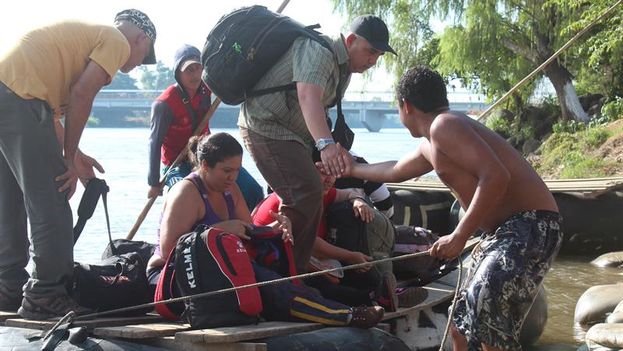
![]() EFE (via 14ymedio), Tapachula, Mexico, 22 November 2015 — Despite increasing obstacles in their path, the number of Cubans crossing the Mexican border from Central America, in order to get a safe conduct pass that allows them to reach the United States, has increased in recent weeks.
EFE (via 14ymedio), Tapachula, Mexico, 22 November 2015 — Despite increasing obstacles in their path, the number of Cubans crossing the Mexican border from Central America, in order to get a safe conduct pass that allows them to reach the United States, has increased in recent weeks.
Nor has the closure of the border between Nicaragua and Costa Rica, on November 15, stopped Cubans, who travel in large groups of up to 500 people and who, for a payment of five dollars, cross the international Suchiate River separating Mexico and Guatemala on rafts every day.
Nicaragua closed its border to the migrants after accusing Costa Rica of throwing them at its door.
“It’s a difficult process where they don’t know if they’ll be allowed to continue; they are waiting to see if the situation is resolved and they can get to Guatemala. We are the first group, they have given us the safe conduct passes and we made it this far,” EFE was told by Oricesar, a migrant who managed to cross Nicaragua and reach Mexican soil.
Traveling in his group of 50 Cubans were also Luis Enrique and his wife, who, helped by a “guide,” made it in six days to the Mexican state of Chiapas. They denounced that “more than two thousand Cubans are stranded in Costa Rica, and if they don’t open the border with Nicaragua the number will be more than 3,000 within a week.”
They avoided talking about internal Cuban politics, but agree that they left the Caribbean nation because of “the poverty and the mistreatment by the authorities,” without regard to their “suffering humiliation in the migration through the countries of Latin America” in order to get to the United States.
In Mexico, the National Migration Institute registered, as of 18 November, the entrance of 9,100 Cuban migrants, of whom 7,317 were housed in the 21st Century Station in Tapachula, Chiapas. These are figures well above the 1,817 who were received during all of 2014.
In the last week some one thousand Cubans entered Chiapas to voluntarily surrender themselves to the immigration authorities
In the last week some one thousand Cubans entered through Chiapas to voluntarily surrender themselves to the immigration authorities and request that the departure office allow them to travel, without restrictions, the last 3,000 miles of the route to US soil.
Efrain Hernandez, 22, a native of Havana, is one of them; he tells EFE that he traveled 3,000 miles to get to Mexico from Ecuador, through Colombia, Panama, Costa Rica, Nicaragua, El Salvador, Honduras and Guatemala.
From that list of countries, men and women complain that they suffered the greatest corruption at the hands of the police in Colombia, because they were charged $100 each to pass through that South American nation.
To get to the southern border of Mexico, the Cubans invest between $5,000 and $6,000 to pay for transportation, lodging and food “in search of a better life for my family,” says Joan Peña, who after obtaining the safe conduct pass, in three days, is on the final leg of his journey, in a hotel in the center of Tapachula where he pays five dollars a night.
Those who are traveling have sold their houses and left their families and jobs, like Maybelli Fernandez, a native of Matanzas. After having surrendered to the authorities they are transferred to the migration offices to complete the paperwork in the departure office, which gives them 30 days to reach the northern border and their final destination.
The undersecretary of Migrant Assistance in the Ministry for the Development of the Southern Border of the Government of Chiapas, Victor Moguel, rejects the idea that the arrival of thousands of emigrants is creating a humanitarian crisis.
On the contrary, Cubans keep hotel occupancy figuresup and fill the daily flights and buses that travel to Mexico City and Tijuana.
For now, Mexico and Cuba do not have a treaty for the deportation of migrants from the island country; however, moved by the rumor that this could happen, Cubans arriving at the border are ever more fearful that, in 2016, the borders between Mexico and Central America might be closed.
